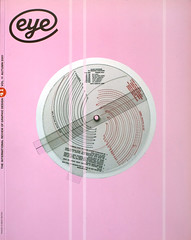Autumn 2001
Looking closer than before
Looking Closer: AIGA Conference on Design History and Criticism
24-25 February 2001, New York‘Looking Closer’ targets the increasing number of designers, design educators and students who are thinking about, writing about and teaching design history and criticism. Master organiser Steven Heller and conference co-chair, Alice Twemlow, acknowledge the desire for a high-level discussion of these topics by providing this forum that seeks to ‘inspire, validate and critique design practice’.
Day one investigated the nature of contemporary design criticism with seven presentations and one panel discussion that focused on terms and context (Rick Poynor, Johanna Drucker, Matthew Soar, design press panel), case studies (Naomi Klein, Steven Johnson) and views from the outside (Elvis Mitchell, Michael Bierut). Day two focused on history, with nine presentations representing a diversity of viewpoints (Neal Gabler, Andrew Blauvelt, Ellen Lupton, panel on popular culture, Victor Margolin, Jeremy Aynsley, Tobias Frere-Jones and Jonathan Hoefler, Maud Lavin, Meredith Davis and Jack Williamson), and a tenth presentation discussed copyright law (Janet Hicks and Frank Martinez).
Overall, the presenters offered an invigorating mix of viewpoints. Of the 250 conference attendees (it was sold out), many were from the design education community. When I shared my impressions with new acquaintances and colleagues, I often found that what inspires me does not always do the same for others. With this in mind, I invited several attendees to express their views and collectively become the voice of this review.
‘I felt this was a very successful event, bringing together some good thinkers and an amazing audience … Some of the “remarkable” speakers were Rick Poynor (the role and value of the design critic precisely argued), Johanna Drucker (graphic design as a model of cultural history); Andrew Blauvelt (the importance of designers dealing with words as a vital part of the message).’ Louise Sandhaus
‘Naomi Klein was the best of the speakers. Her manner was commanding, yet accessible and she was candid, comfortable and extremely well-informed about her topic … her message was clearly about being “informed” and not necessarily about being a “radical non-commercialist”.’ Donna Stanton
‘Johanna Drucker took the day with her keen analysis of twentieth-century design languages, the schism with semiotics and rhetoric and the current notions of "meta-language". I felt she was urging an emerging trend to refer to the intimate characteristics of the object itself as a point-of-view about criticism.’ Tom Briggs
‘Victor Margolin presented a unique history focused on a racially identified subject and not one with which the speaker identifies (“African-American Designers: The Chicago Experience”). It seemed significant that this work has been done by Margolin … a patriarch of the design history/criticism sphere. For me, the most poignant moment in the presentation was the realisation that there were very few African-American representatives in the conference’s population.’ Tom Briggs
‘The programme needed a different balance in the topic of criticism. Rather than just presentations from critics, it would have been a godsend for educators to have had more concrete discussions, examples and ideas about applying and refining the concept of design criticism.’ Jan Conradi
Over the two days the atmosphere was sociable and people enjoyed networking. My only gripe lies with the tightly packed schedule that competed with the desires of many to have even more time for conversation.
Elizabeth Resnick, designer, teacher, MassArt, Boston
First published in Eye no. 41 vol. 11, 2001
Eye is the world’s most beautiful and collectable graphic design journal, published quarterly for professional designers, students and anyone interested in critical, informed writing about graphic design and visual culture. It is available from all good design bookshops and online at the Eye shop, where you can buy subscriptions and single issues.

